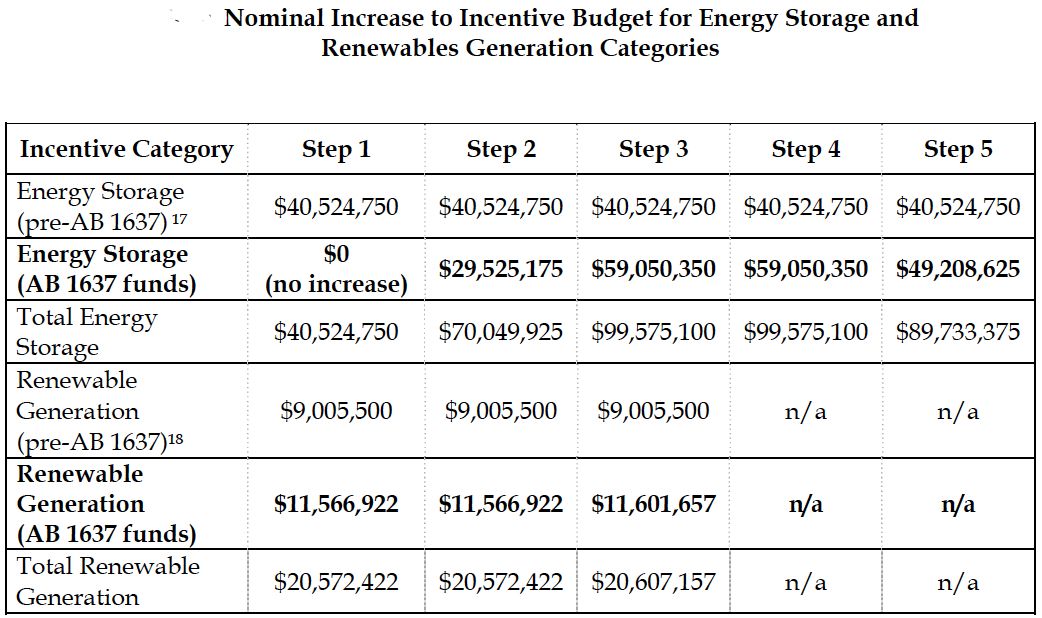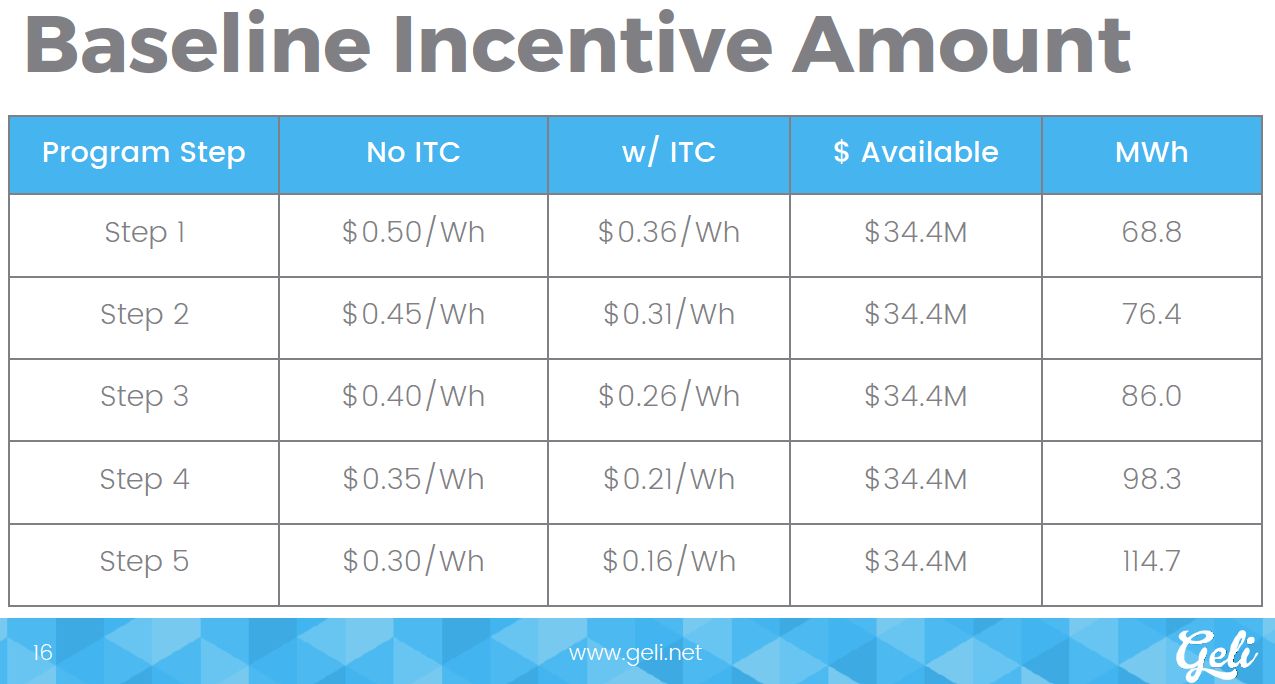There's a new and bigger renewables subsidy now in effect in California, unanimously approved last week by the Public Utilities Commission, that has the potential to light up the energy storage market.
The Self-Generation Incentive Program (SGIP) has been boosting distributed energy in California for years. It was the chief subsidy for solar prior to the enormously effective California Solar Incentive (CSI). But the generous (approximately $80 million per year) SGIP has not always been perfectly aligned with its goal of deploying low-carbon distributed energy sources that support grid needs in an equitable fashion.
The monies for the subsidy come from ratepayers and are collected by California's large investor-owned utilities.
GTM has reported on the program's flaws, as well as allegations of some participants gaming the system -- the program's bid submission process had allowed one or two vendors to dominate recent bidding rounds. The relative "greenness" of some of the subsidized technologies has also been debated. The program has been the mainstay of more than a few storage and fuel cell firms, but was put on pause as the CPUC grappled with the changes that needed to be made.
In May of last year, California Public Utilities Commission President Michael Picker issued a proposed decision (PDF) that would make these reforms:
- Reserving 75 percent of program dollars for energy storage projects
- Making the incentive money available on a continuous basis in a declining incentive "step" structure (akin to the California Solar Initiative)
- Replacing the first-come, first-served system with a lottery in which projects with additional greenhouse gas/grid benefits are given priority
- Restricting each project developer to a cap of 20 percent of the incentive budget, rather than the previous 40 percent cap that applied to equipment builders
At the time, law firm Wilson Sonsini Goodrich & Rosati noted: "Although a prior CPUC staff proposal had recommended ending the allocation of incentives to natural-gas-fired electric-only fuel cells and microturbines, the proposed decision would allow these technologies to remain in the SGIP. Of the 25 percent of the total SGIP budget set aside for generation projects, 10 percent is reserved for renewables, however, and gas-fired technologies must be at least 10 percent bio-gas-fueled beginning in 2017, increasing to 100 percent by 2020."
Ravi Manghani, GTM Research's director of energy storage, noted at the time that the program's proposed changes make it "look a lot like the California Solar Initiative in design." He added that there is a "15 percent carve-out for small systems less than 10 kilowatts in size."
He also pointed out the proposed increase in discharge requirement for commercial storage from 104 hours per year to 260 hours per year, and an increase in the application fee from 1 percent to 5 percent.
Doubling the funds available to $166 million per year
Last month, these additional changes were proposed in AB 1637:
- PG&E, SCE, SDG&E and Southern California Gas will collect "on an annual basis through 2019, double the amount collected in calendar year 2008." That's $166 million per year.
- 85 percent of the additional funding authorized by AB 1637 will be allocated to the energy storage category -- but no AB 1637 funds are allocated to the existing carve-out for energy storage projects less than 10 kilowatts in size. The joint investor-owned utilities, Silicon Valley Leadership Group, CalSEIA, SolarCity/Tesla, and Sunrun supported a 75 percent energy storage/25 percent generation split, according to the proposed decision.
- 15 percent of the AB 1637 funds are available for renewable generation projects.
"SGIP has been a successful program that played a critical role in the deployment and commercialization of both solar and fuel cell technologies, and now the commission has focused the program almost exclusively on accelerating the commercialization of storage technologies," observed Bloom Energy VP of marketing and customer experience Asim Hussain.
Walker Wright, VP of public policy at Green Charge Networks, said the changes "essentially made the SGIP program more of an energy storage program and less of a fuel cell program." Wright added, "This is a big deal for a small, emerging industry."

A bit of tension
Comments from stakeholders offered a wide range of choices on how to distribute the new funds across the incentive steps and available technologies. Opinions differed on the best way to prioritize bids once funds from different steps were exhausted.
To some extent, it pitted the standalone energy storage firms such as Stem and AMS against independent solar installers. Now, if a program step is oversubscribed, a project enters a lottery system that includes preferences related to location (such as Southern California Edison's West L.A. Local Reliability Area), as well as giving storage-plus-solar priority over storage-only projects.
Polly Shaw, VP of regulatory affairs and communications for standalone energy storage firm Stem, told GTM, "After seeing unexpectedly large solar developer interest in the recent SGIP workshop, a group of standalone storage companies proposed some additional 'good governance' ideas to the CPUC on just the additional AB 1637 SGIP monies to ensure the incentives fund ready projects."
Shaw added, "We think the commission should think again about introducing a new program priority, equal to solar-storage and Aliso Canyon siting, but only starting in Step 2 if it sees unduly high solar demand. We think it’s in the ratepayers' and customers’ interest to prioritize incentives for projects that offer multiple grid and customer benefits to get the most ‘bang for the buck.’"
The standalone energy storage suppliers suggest that systems offering grid benefits should receive priority.
Energy storage software provider Geli's director of marketing and strategy, Andrew Krulewitz, contends that solar-plus-storage "does benefit the grid."
"Solar is going to keep coming on to the grid, resulting in more and more negative price events. Pairing solar with batteries (coupled with the ITC forcing batteries to charge off of the solar) makes solar inherently more dispatchable, a win for the grid, and a win for solar installers," said Krulewitz.
$0.50/Wh
Geli provides a guide to the SGIP and some C&I energy storage baseline incentive amounts.
Generate Capital issued a note on the program. "With the falling costs of battery storage and additional incentive from the federal tax credit, solar-plus-storage is finally ready to become a standard offer presented to commercial and industrial customers."
But Generate also pointed out that "there will be five declining incentive blocks. Further, solar-plus-storage projects are given a preference in the program to encourage low-carbon generation. What is that incentive level? You might want to be sitting down for this: Commercial storage deals will be offered 50 cents per watt-hour (36 cents for solar-plus-storage because of the existing benefit of the ITC). Let’s make something clear: This isn’t a kilowatt-hour (which is 1,000 watts); it’s single watt-hour."

That generous incentive is why Generate is putting $250 million to work in storage applications.
"The SGIP will make solar-plus-storage more cost-effective than solar-only for many customers. As with most commercial systems, the savings are real, but not the real reason to go solar. Most customers make the switch to protect themselves from ever-rising electricity rates. Other customers value backup power and resiliency -- these customers will love solar-plus-storage. As the utility companies shift rate increases from electricity prices to demand charges, commercial customers that opt for solar-plus-storage will be protected. If you live in California, the SGIP will pay you for something you already want," claim documents from Generate Capital.
According to Jigar Shah, president of Generate, California is putting up a "big tranche of cash."
His firm contends,"There has never been a better time for solar developers or customers to add energy storage to their systems." Generate sees California "giving battery storage another shot in the arm."
But as Polly Shaw of Stem noted, "Incentive programs are hard to design."
"The decision was laudable in that it set aside the new monies largely for storage and moved the funds up to earlier steps. Adding the funds equally to Step 1 would have been most optimal for ensuring access for a wider range of project types," said Shaw.
Additionally, energy storage can benefit the grid but not always on the the side of reduced GHG emissions. The commission has little evidence to show that GHG reductions have been achieved by current storage projects from these ratepayer-funded incentives. As GTM VP Shayle Kann has pointed out, sometimes energy storage performs in counterintuitive ways.
The SGIP will reopen to energy storage applicants on May 1.
Join GTM for a deep dive into the budding domestic energy storage market at the U.S. Energy Storage Summit 2017. Utilities, financiers, regulators, technology innovators, and storage practitioners will all come together for two full days of data-intensive presentations, analyst-led panel sessions with industry leaders, and extensive, high-level networking. Learn more here.



